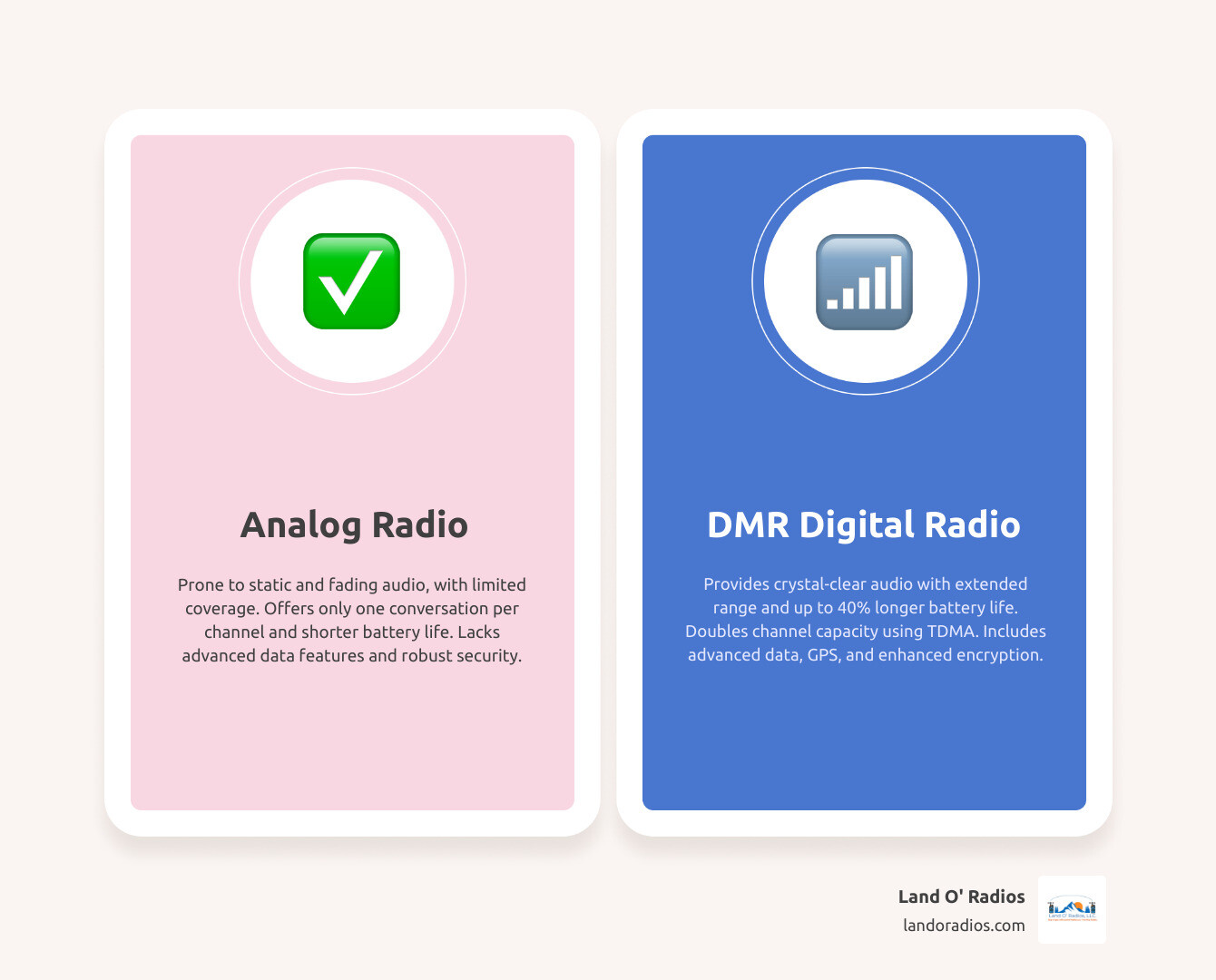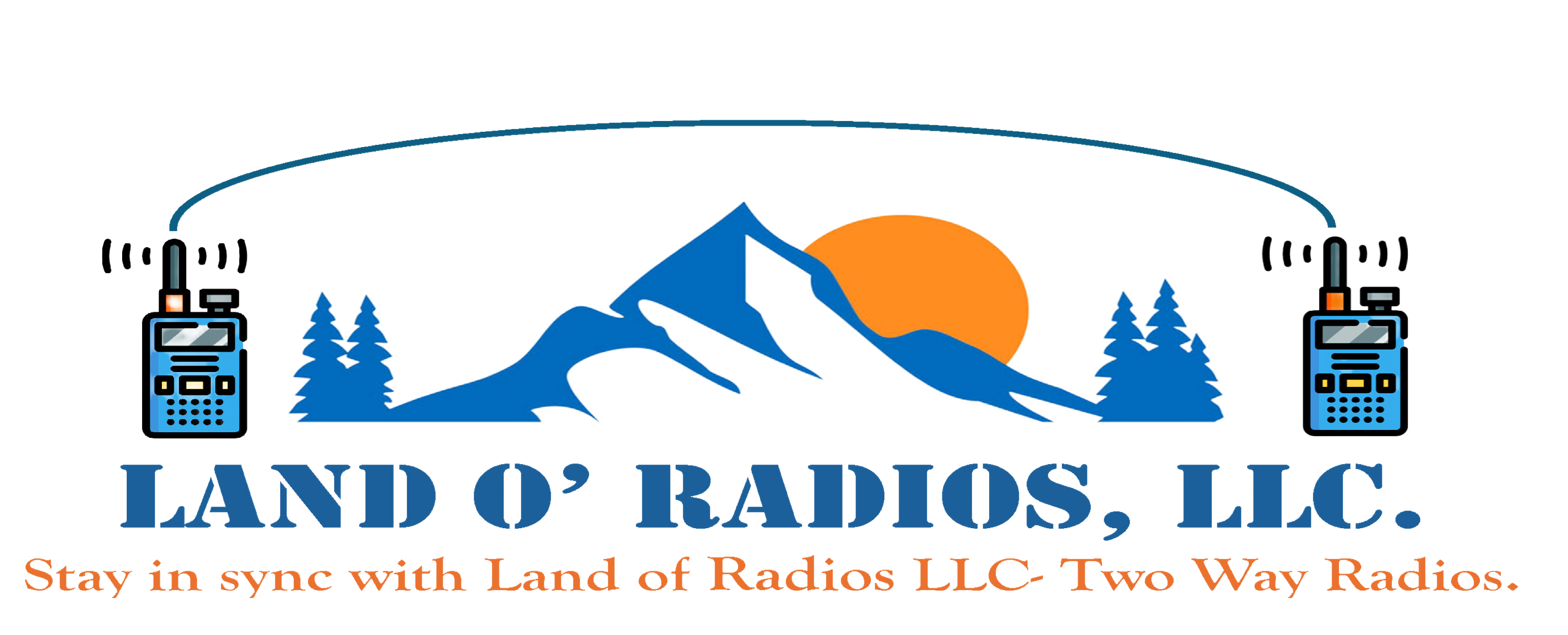Why Digital Two-Way Radios Are Changing Professional Communication

If you've ever dealt with crackling static, lost messages, or batteries dying mid-shift, you know the limits of analog radios. While they've been a professional staple for decades, today's demanding work environments require a more robust solution. Digital Mobile Radio (DMR) is that solution, offering a significant upgrade in performance and capability.
Developed by the European Telecommunications Standards Institute (ETSI) in 2005, DMR is an open digital standard that transforms team communication. The core dmr digital two-way radio benefits include:
- Crystal-Clear Audio: Digital noise cancellation delivers intelligible voice quality, even in loud environments or at the edge of coverage.
- 40% Longer Battery Life: Radios last through entire shifts without a recharge.
- Doubled Channel Capacity: Time Division Multiple Access (TDMA) technology allows two simultaneous conversations on a single channel, improving efficiency without new licenses.
- Improved Security: Strong encryption options protect sensitive communications from eavesdropping.
- Advanced Features: Integrated GPS tracking, text messaging, and data applications are built-in.
- Seamless Migration: Dual-mode radios can operate on both digital and analog channels, allowing for a phased, budget-friendly upgrade from an existing analog system.
Where analog signals fade into static, DMR provides consistent clarity. It doubles your call capacity and extends battery life, solving the most common frustrations of traditional systems.
I'm Rene Fornaris, and with over ten years of experience at Advanced Radio Systems, I've seen DMR transform operations for construction, security, and logistics teams. At Land O' Radios, I'm here to help you understand how this technology can solve your communication challenges.

Unpacking the Core DMR Digital Two-Way Radio Benefits
The shift from analog to digital solves real-world problems that affect your team's efficiency and safety. Let's explore the core dmr digital two-way radio benefits that make this technology a worthy investment.
Superior Performance: Improved Audio, Range, and Battery Life
Frustrations like poor audio and dead batteries disappear with DMR technology. The improvements are immediately noticeable.
Audio Quality is where DMR excels. Analog radios transmit all sound, including background noise and static. DMR uses digital signal processing, including Forward Error Correction (FEC), to filter out noise and correct transmission errors. The result is crystal-clear conversation, even with jackhammers pounding nearby. This clarity holds right to the edge of your coverage area, where analog signals typically degrade into unintelligible static.
Coverage Area is more consistent with digital technology. While analog signals weaken and become fuzzy with distance, DMR provides clear audio across the entire operational area. The signal either comes through perfectly or not at all, eliminating frustrating "fuzzy zones." Paired with repeaters, DMR systems overcome obstacles like buildings and terrain more effectively than analog.
Battery Life increases by up to 40% thanks to Time Division Multiple Access (TDMA). DMR splits a frequency into two time slots, and a radio only transmits during its assigned slot. This means the transmitter is idle about half the time, even during a conversation. Since transmitting consumes the most power, this efficiency ensures radios last through a full shift without needing a recharge.
For more tips on maximizing your equipment, see our guide on Two-Way Radio Training: Best Practices for New Users.
Best Efficiency and Advanced Capabilities
DMR transforms radios into versatile communication platforms with capabilities impossible for analog systems.

Channel Capacity is doubled without needing more licenses. TDMA splits a single 12.5 kHz channel into two independent time slots, allowing two separate conversations to occur simultaneously on the same frequency. This is transformative for busy operations, as it reduces congestion and lowers spectrum licensing costs.
Data Applications turn radios into multi-functional tools. GPS tracking allows dispatchers to monitor team locations for improved safety and efficiency. Text messaging offers a discreet way to send detailed instructions without tying up voice channels. Advanced systems can even support telemetry for monitoring remote equipment.
Flexible Calling adapts to any situation. DMR supports private one-to-one calls, group calls for teams, and all-calls for broadcasting critical announcements. Emergency calls get priority, and some systems can even connect to telephone networks or integrate with Push-to-Talk over Cellular (PoC) platforms.
Learn more about protecting these advanced communications in our guide Secure Your Communication with These Security Radios.
Strategic Advantages: Security, Migration, and Future-Proofing
Beyond daily operations, DMR delivers strategic advantages that protect your investment and prepare your organization for the future.
Improved Security and Privacy is a key benefit. Analog conversations can be easily monitored with a basic scanner. DMR offers robust digital encryption (from ARC4 to AES 256-bit) that scrambles transmissions, making them unintelligible to eavesdroppers. If a radio is lost or stolen, it can be remotely deactivated ("stun") to prevent unauthorized use.
Seamless Migration from Analog is possible because many DMR radios are dual-mode, meaning they can operate on both new digital channels and your existing analog channels. This allows for a phased, budget-friendly transition. You can gradually replace radios over time, and users with new dual-mode radios can switch to analog channels to communicate with legacy equipment, ensuring no one is left out during the upgrade process.
Cost-Effectiveness and Future-Proofing make DMR a smart long-term investment. A single DMR repeater can support two simultaneous calls, doubling your capacity without the cost of a second repeater and license. As an open standard from the European Telecommunications Standards Institute (ETSI), DMR fosters competition among manufacturers, ensuring competitive pricing and continuous innovation. This future-proof design protects your investment for years to come.
Here's how analog and DMR systems compare:
| Feature | Analog Radios | DMR Radios |
|---|---|---|
| Voice Transmission | Frequency Modulation (FM) | Digital encoding into binary packets |
| Audio Quality | Degrades with distance, prone to static and noise | Clear and consistent to edge of coverage, noise cancellation, error correction |
| Channel Capacity | One conversation per 12.5 kHz channel | Two independent conversations per 12.5 kHz channel (TDMA) |
| Battery Life | Shorter, transmitter always on | Up to 40% longer, transmitter idle half the time |
| Data Capabilities | Limited to none | GPS, text messaging, telemetry, IP data |
| Security | Easily intercepted, no built-in encryption | Robust encryption (ARC4, DES, AES), call authentication |
| Migration | Requires full system replacement for digital features | Dual-mode radios allow phased transition |
| Cost | Lower initial hardware, less efficient spectrum use | Higher initial hardware, lower operational costs, efficient spectrum use, future-proof |
Implementing DMR: Systems, Industries, and Your Next Steps
Understanding the dmr digital two-way radio benefits is the first step; putting them to work is next. DMR is flexible enough to fit any size operation, from small businesses to large enterprises.
Understanding DMR Tiers and System Components
DMR is not a one-size-fits-all solution. It's a family of systems designed for different needs, organized into three tiers.
- Tier I: Unlicensed, low-power radios for personal use (primarily in Europe). Not recommended for professional environments.
- Tier II: The most common professional solution. These are conventional licensed systems using repeaters to extend coverage. Tier II delivers all the core DMR benefits, including doubled capacity, clear audio, and data features. It's ideal for construction, security, and hospitality.
- Tier III: Advanced trunked radio systems for large organizations with hundreds of users. A control channel dynamically assigns frequencies, managing traffic flow for mission-critical operations like public safety or major utilities.
Your DMR system will use a combination of hardware:
- Handheld Portables: Compact, rugged devices for mobile team members.
- Mobile Radios: Higher-power units installed in vehicles for superior range.
- Repeaters: The infrastructure backbone that receives and re-transmits signals to eliminate dead zones and extend coverage.
To learn more about what sets professional equipment apart, read our guide on the Top Five Differences Between Two-Way Radios and Walkie-Talkies.
Real-World DMR Digital Two-Way Radio Benefits Across Industries
DMR's versatility allows it to transform operations across nearly every sector.

- Public Safety & Emergency Services: Secure, encrypted channels protect tactical information, while GPS tracking coordinates response units. DMR systems remain reliable when cellular networks fail.
- Transportation & Logistics: Fleet managers use GPS to monitor vehicles and send route updates via text. Extended coverage ensures reliable communication in rural areas. Learn more in our article on How Motorola Solutions is Revolutionizing Trucking Safety with Smart Communications.
- Manufacturing & Industrial: Superior noise cancellation allows for clear communication on loud factory floors. Rugged devices withstand harsh environments, and safety features like Man Down protect lone workers.
- Utilities & Energy: Field crews stay connected across vast service territories. DMR provides reliable voice, GPS tracking, and data telemetry for monitoring remote infrastructure.
- Hospitality & Event Management: Teams coordinate discreetly using group calls and text messaging. At large events, DMR's capacity and clarity keep logistics, security, and guest services running smoothly. Improve your operations with Serve Up Better Communication with Hospitality Radios.
Making the Switch to Digital Communication
The case for digital is compelling: clearer audio, longer battery life, doubled capacity, and robust security. DMR is a smart long-term investment because it grows with you. You can start with a basic Tier II system and expand as your organization evolves, without being locked into a single vendor or obsolete technology.
This future-proof design protects your investment and ensures your communication platform will support your operations for years. At Land O' Radios, our team has the expertise to understand your unique challenges. We'll guide you through selecting the right DMR radios and system configuration for your needs and budget, whether you're in West Miami or across the country.
Ready to experience the benefits of digital communication? Explore our curated selection of commercial radios and find the perfect fit for your team in Tune In: The Best Commercial Radios for Every Need 2025.








